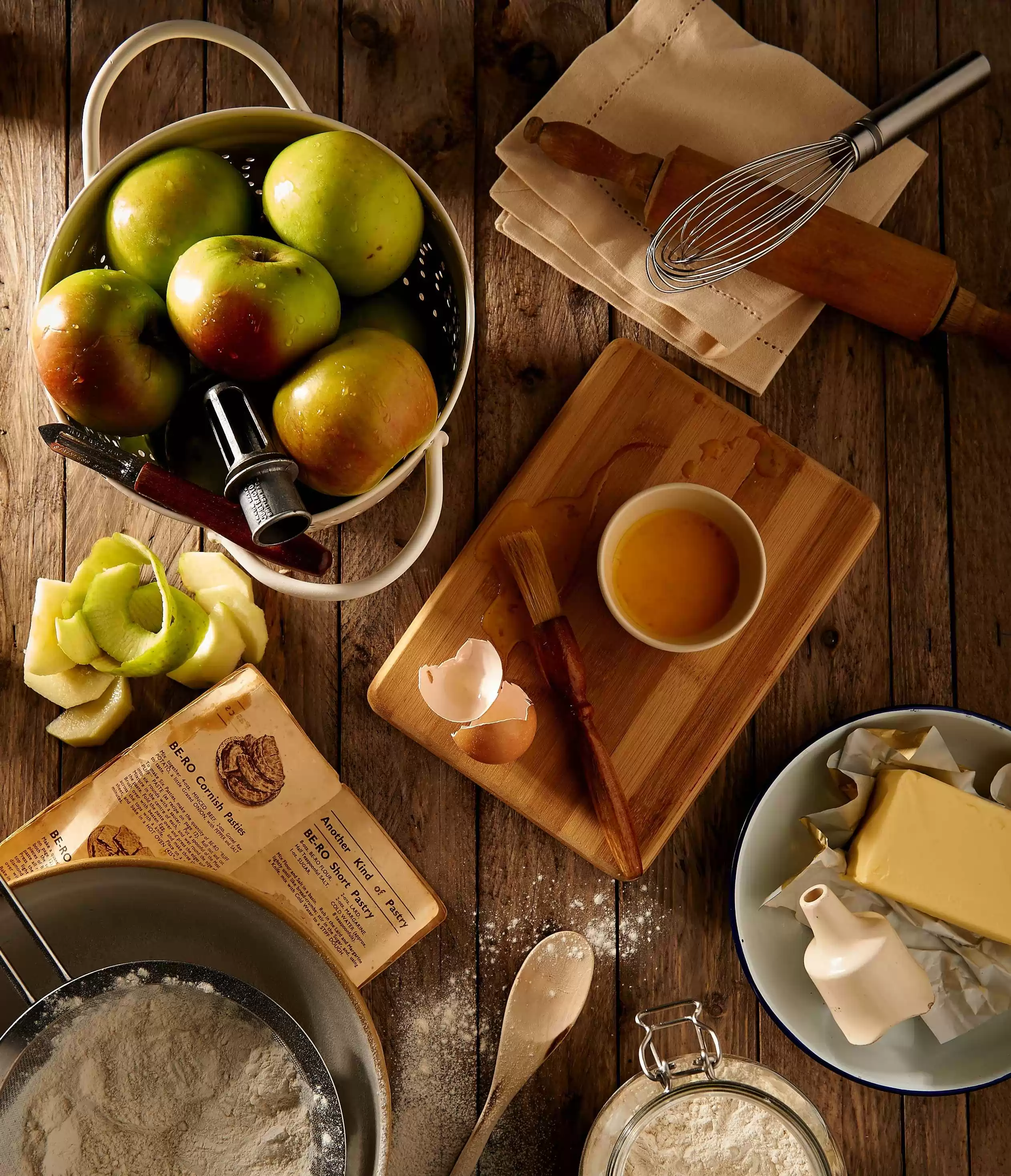Detailed content of our market study
 Inforamtion
Inforamtion
- Number of pages : 35 pages
- Format : Digital and PDF versions
- Last update :
 Summary and extracts
Summary and extracts
1 Market overview
1.1 Market definition and evaluation
The cookware market occupies a strategic position in the world of tableware, accounting for 19% of final consumption by French households, just behind tableware (22%). Long confined to a purely functional role, these everyday items now embody a domestic equipment issue in their own right, at the crossroads of practicality, nutrition and well-being at home.
In France, the sector is undergoing a profound transformation in its uses, distribution channels and industrial challenges. On the manufacturing side, the production fabric remains concentrated in a few historic basins, notably Auvergne-Rhône-Alpes, Hauts-de-France and Bourgogne-Franche-Comté, which between them are home to several dozen sites specializing in household metal goods. These regions capitalize on long-standing know-how, but face growing competitive pressure from China, Germany and Italy, particularly in low-cost or high-tech segments.
On the commercial front, the transformation of distribution channels is just as striking. By 2023, distance selling has become the sector's most dynamic distribution channel, with growth of +17%, driven by the boom in e-commerce and new consumer habits. Against this backdrop, brands must redouble their efforts to make themselves visible, understandable and attractive online, while maintaining a bond of trust with consumers.
The latter, in fact, are expressing ever-increasing expectations in terms of time-saving, ease of use and health safety. In 2024, 72% of French people say they spend less than 4 hours a week in the kitchen, compared with 64% five years earlier, according to Nielsen IQ. This time constraint favors multifunctional, ergonomic and fast-cooking equipment, as demonstrated by the spectacular sales of Airfryers and ceramic frying pans. At the same time, public health and regulatory issues are calling certain materials into question: although utensils have been temporarily excluded from France's PFAS law, a European regulation is still under consideration, presenting manufacturers with the dual challenge of innovation and compliance.
Finally, on the export front, France has a structural trade deficit, with 401.5 million euros in imports for 155.8 million euros in exports in 2024. This imbalance, though historic, is tending to narrow, with exports up +20% since 2021, boosted in particular by the upmarket positioning of certain national players.
This study proposes to analyze the structure of the French cookware market, through its production, distribution, consumption and regulation logics, based on the most recent data available and the weak signals shaping the sector's future.
1.2 A dynamic global market, driven by e-commerce and Asia
The global cookware market is estimated at $**.* billion in **** and is expected to reach $** billion by ****, representing a CAGR of +*.**% over the period ****-**** (***). This dynamic reflects the lasting evolution of post-Covid consumption patterns: the return to home cooking, the focus on food wellness, but also the rise of modular kitchens have redefined consumer expectations on a global scale.
Among the key factors, the rapid growth of e-commerce stands out. By facilitating access to a wide range of products and services, notably via specialized marketplaces, it is strongly supporting the sector's growth, particularly in emerging economies. Consumers, who have become more flexible in their budgetary choices, are devoting a growing share of their household spending to kitchen fittings and associated utensils.
Size of the global cookware market France, ****-****, in $ billion Source: ****
The Asia-Pacific region clearly dominates the market, accounting for over **% of global share. The massive adoption of gas stoves in countries such as India and China, combined with sustained population growth and rapid urbanization, is fuelling ongoing demand for functional, affordable products.
Finally, the competitive landscape remains structured around major international groups such as Groupe SEB, Fissler, Meyer Corporation and the Werhahn Group, which are investing heavily in online ...
1.3 A French market returning to growth
Tableware market structure by product family France, ****, in % of final consumption Source: ****
To estimate the size of the French cookware market, we rely on data from the Confédération des Arts de la Table, which brings together the main players in the sector. It distinguishes three main areas: tableware, kitchenware and decorative items. The kitchen perimeter includes pots, pans, cookware, various utensils, small appliances (***) as well as cutlery.
from the structure of the **** market (***), we can extract two segments directly related to kitchenware:
Cookware: these account for **% of a global market estimated at €*,*** million, or around €*** million. This mainly includes pots, pans, dishes, lids and associated utensils. Small portable appliances: with a share of **.*%, or *** million euros, this segment includes products related to food preparation (***), as well as other appliances. Using a conservative assumption of **% relevance for our scope, we add *** million euros to our estimate.
In total, the estimated size of the cookware market in France in **** is therefore around *.** billion euros.
Estimated size of the cookware market in France France, ****-****, in billions of euros Source: ****
To estimate the size of the cookware market in France between **** and ****, we used sales index data from INSEE, based on NAF ...
1.4 Foreign trade structurally in deficit but growing steadily
Imports of cookware by value France, ****-****, in thousands of euros Finances.gouv
Foreign trade in cookware illustrates a contrasting dynamic between strong exports and persistent dependence on imports. In ****, France exported ***.* million euros worth of cookware, compared with ***.* million euros in ****, an increase of +**.*% in three years. This steady growth testifies to the company's recognized expertise, which is winning international customers, particularly in the high-end segment. The increase is continuous, with milestones reached each year: +**.* M€ between **** and ****, then +*.* M€ between **** and ****, and +*.* M€ between **** and **** (***).
Imports of kitchen utensils by value France, ****-****, in millions of euros Finances.gouv
However, these good results are still insufficient to offset the scale of imports. In ****, foreign purchases reached ***.* million euros, or *.* times more than exports. Despite a moderate decline since **** (***).
Tableware imports and exports France, ****, in Source: ****
These figures reflect a structural dependence on Asian suppliers, particularly for low-cost plastic and metal utensils. Exports, on the other hand, focus on high value-added products , often positioned in high-end or professional niches, which explains their more stable growth over time.
The French market is therefore structured around an imbalance, but the move upmarket by certain national manufacturers suggests a partial recovery of market ...
2 Demand analysis
2.1 A market based essentially on household consumption
The cookware market is above all driven by household consumption patterns, on which it is largely dependent. In ****, French household spending will be divided between manufactured goods (***). Kitchen utensils, as manufactured goods, are therefore one of the most important consumption items, alongside food, with which they are directly linked.
Household consumption expenditure France, ****, in Source: ****
This dynamic is part of a context of rising consumption. Between January **** and January ****, total household spending rose from *.** to **.* billion euros (***), confirming a recovery in demand for household equipment. This growth suggests a renewed interest in investing in the living environment and everyday practices, of which the kitchen is an integral part. In a context of budgetary trade-offs, kitchen utensils can be a lever for cooking more at home, reducing the proportion of meals spent away from home, while preserving culinary quality and pleasure
Total French household consumption on the rise France, January ****-January ****, in € billions Source: ****
2.2 Urbanization and urban lifestyles
Increasing urbanization in France is resulting in a higher concentration of the population in large conurbations. According to data from theUniversity of Sherbrooke, the proportion of the population living in cities with more than one million inhabitants will rise from **.*% in **** to **.**% in ****. These changes in urban lifestyles have a direct impact on demand for cookware.
changes in cookware requirements:
Urbanization is changing eating habits and, by extension, culinary equipment purchases. Several trends are emerging:
Downsizing kitchens and optimizing spaceWith urban densification, homes are becoming smaller, implying an increased need for compact, multifunctional and ergonomic cookware. Foldable, stackable and modular products are gaining in popularity. Preference for fast, practical utensilsThe accelerated pace of urban life reduces the time available for cooking. Consumers therefore prefer equipment that facilitates rapid meal preparation: multi-function food processors, electric pressure cookers, quality non-stick pans, etc. Influence of new food trendsAs urban areas are often hubs of culinary innovation, demand for specialized utensils grows with new trends (***). Increased consumption of home-cooked mealsWith growing concerns about health and food quality, urbanites are investing more in equipment for home cooking, such as pressure cookers, blenders and utensils made from non-toxic materials. The rise of e-commerce and digitalizationUrbanization favors e-commerce, ...
2.3 Demand driven by the restaurant and hotel industries
The traditional catering sector plays a central role in the demand for cookware in France. Although the Covid crisis temporarily slowed activity, the recovery has been solid and continues to gain momentum. INSEE's NAF code **.**A, which covers establishments offering table service, is a key indicator of the dynamism of the traditional catering sector. This sector, directly linked to the need for kitchen utensils, influences demand for products such as frying pans, knives, cutting boards and other essential accessories for professionals and individuals alike, inspired by trends in the sector.
Sales index for traditional foodservice France, ****-****, index base *** in **** Source: ****
Thesales index for traditional foodservice in France has recovered strongly after two difficult years (***), reaching its highest level in ****. This growth indirectly supports demand for cookware, as a flourishing restaurant sector stimulates consumer interest in home cooking and the equipment that goes with it.
In addition, the number of traditional catering establishments has remained stable over the last decade, with **,*** establishments in ****, testifying to a structured and buoyant market.
Furthermore, household spending on catering services has been rising sharply since ****, even if a slight slowdown was observed in ****. This phenomenon reflects a craze for gastronomy and culinary experimentation, reinforcing the ...
2.4 The value of cooking as a culture feeds domestic practices
While French cuisine still holds a special place in the hearts of the French (***), it is now perceived above all as a cultural and emotional universe. Indeed, **% of respondents consider that gastronomy enables them to discover other cultures, and just as many believe thata dish can arouse strong emotions.
French cuisine preferences France, ****, in Source: ****
this artistic and emotional perception of cuisine is also illustrated by the fact that **% of French people compare certain chefs to artists, and **% consider gastronomy to be an art in its own right.
Percentage of French people not wishing to visit certain types of restaurant France, ****, in % Source: ****
However, this appreciation does not necessarily translate into increased patronage of high-end dining establishments. **% of French people say they have no desire to go to a Michelin-starred restaurant, and **% to a gastronomic restaurant. These establishments, emblematic of culinary excellence, are also those where the most advanced professional utensils are used (***). this disengagement seems to reinforce the importance of home cooking as a means of culinary expression.
french food expenditure over * years France, ****, in Source: ****
At the same time, out-of-home food spending is on the decline: **% of French people have reduced their restaurant spending over the past five years, ...
2.5 An enduring craze for household appliances
Household appliance ownership in France reflects a strong attachment to these everyday tools, which complement the range of traditional kitchen utensils. On average, **% of households own a coffee-maker, including **% pod coffee makers, **% filter coffee makers and *% automatic coffee makers, with a strong presence in the breakfast segment. When it comes to cooking, **% of households own a toaster, **% an electric mixer and **% a raclette machine, hand blender or kettle.
French household appliance equipment rate France, ****, in Source: ****
This wide distribution reflects not only a high equipment rate, but also stability over time: the average length of ownership reaches ** years for a toaster or hairdryer, compared with ** years for major household appliances, underlining the longevity and regular use of these products.
Average ownership of appliances France, ****, in years Source: ****
Finally, their use is fully integrated into everyday life: toasters are used on average *.* times a week, far more than hairdryers (***), confirming their central role in domestic food practices. These data show that small electrical appliances are a natural extension of kitchen utensils and a structuring segment of the market.
Frequency of weekly use France, ****, in number of uses per week Source: ****
2.6 Favourite Brands in France
Brand awareness plays an essential role in the cookware market. In February ****, an Opinionway survey revealed that Tefal (***) are the six most popular brands in this universe.
French people's favorite cookware brands France, February ****, in Source: ****
These brands share several characteristics: a strong presence in households, a wide range covering both classic utensils (***) and small kitchen appliances, and an ability to innovate to meet new domestic expectations. Tefal, Seb and Moulinex, all part of the SEB Group, confirm their historic supremacy, with a positioning that is both mainstream and technically accessible.
However, popularity varies according to profile. Women in particular prefer Tefal (***).
French people's favorite cookware brands, by gender France, February ****, in % Source: ****
Generationally, Tefal appeals to all age groups, with a peak among **-** year-olds (***). Seb and Moulinex are well-established in the **-** and over-** age groups, two target groups sensitive to durability and practicality.
French people's favorite cookware brands, by age group France, February ****, in % Source: ****
kitchenAid and Magimix, with their more upmarket positioning, attract a more CSP+ audience, but are struggling to make inroads with young adults.
Finally, this marked preference for well-known brands reflects a need for reassurance in a market saturated by low-cost offerings. It also ...
3 Market structure
3.1 Value chain
Market value chain
3.2 Declining national production, but contrasting trends
The manufacture of kitchen utensils in France mainly falls under NAF code **.**A: Manufacture of household metal goods. This code covers the production of metal utensils, saucepans, frying pans, baking pans, etc., excluding electrical appliances. This choice is justified by the specialization of this category in domestic cooking equipment, which is at the heart of our scope.
According toUrssaf data(***).
Number of establishments in the Household Metal Goods Manufacturing sector France, ****, in units Source: ****
At the same time, the number ofemployees in the sector will reach *,*** in ****, compared with *,*** in ****. Despite this slight contraction, employment remains resilient overall. This stability suggests an industry that is not subject to massive relocation, but is potentially sensitive to consumption cycles and household price arbitrages, particularly for top-of-the-range products.
Number of employees in the Household Metal Goods Manufacturing sector France, ****, in units Source: ****
The location of establishments shows a high concentration in four industrial regions: Auvergne-Rhône-Alpes (***). This map highlights the historical importance of Eastern France in culinary metallurgy, a legacy of know-how centered on tableware and technical utensils. in contrast, the West, Ile-de-France and Corsica are poorly represented.
French tableware production, all categories combined (***). This trend is explained by a difficult post-Covid recovery, an ...
3.3 A changing retail landscape: the rise of alternative channels
The kitchenware market, integrated into the tableware sector, is undergoing a clear transformation in its distribution channels. In ****, data from theFrancéclat Observatory reveal a marked decline in sales by supermarket chains, whose sales of tableware have fallen by *%, confirming a trend of gradual disengagement.tableware sales fell by *%, confirming a trend of gradual disengagement by these generalist players. The decline was even more pronounced for department stores, down **%, underlining the structural difficulties of this format in a more volatile consumer environment.
conversely, furniture and home furnishings chains (***), is the most dynamic channel, driven by the digitalization of purchasing behaviour and the rise of marketplaces.
tableware sales by distribution channel France, ****, in Source: ****
Specialized channels are not to be outdone: independent retailers and manufacturers' boutiques each recorded moderate growth of +*%, demonstrating their resilience thanks to a more personalized customer relationship and a differentiated offer. on the other hand, specialized organized trade lost *% in sales, perhaps due to a less clear offer in the face of channel fragmentation.
This sales trend is accompanied by a fundamental structural change. Between **** and ****, the number of specialized tableware stores rose by *%, while the number of non-specialized outlets fell bycialized outlets fell by *%, reflecting a reconfiguration ...
3.4 The competitive landscape in the cookware market
On the supply side, the market is characterized by a large number of players and intense competition. Numerous small and medium-sized businesses make up the industrial fabric, yet the majority of sales are generated by major international groups.
For entry- and mid-range items , imports from Asia, taking advantage of low labor costs, have no competitors. In the high-end segments , French manufacturers, and the high reputation of the "made in France" brand, are up against the Italians and Germans. In addition, retailers are in a strong position vis-à-vis manufacturers (***). This keeps downward pressure on prices [***].
Examples of "Made in France" utensils
Rousselon: Manufacture of kitchen accessories (***) and knives. Bourgeat (***): Manufacturer of cookware, utensils and equipment for holding and regenerating food. Professional and private customers. Tefal: Manufactured in Haute-Savoie. Pots, pans, molds and other non-stick utensils are made in France. Peugeot Saveurs: Peugeot grinders for salt, pepper and coffee are made in France. Laguiole Actiforge: Manufacturer of corkscrews (***).
Stores specializing in tableware:
Alice Déclice: state-of-the-art kitchen utensils and appliances. Ambiance & Styles: tableware specialist. Cerf Dellier: specialist in bakery and pastry-making utensils. Culinarion: top-of-the-range kitchen utensils.
3.5 A market driven by the performance of small electrical appliances
In ****, the dynamics of the French household appliances market will be driven almost exclusively by small appliances. While the sector as a whole recorded modest growth of +*% in value, this increase was driven by small appliances, up +*%, while large appliances declined by -*.*%.
Comparative performance between PEM and GEM France, **** sales data, in millions of euros and annual change Source: ****
Small electrical appliances are becoming the real market driver, with **.* million products sold and sales of *.** billion euros, compared with just *.* million appliances sold for *.* billion euros on the large appliance side.
appliance market trends by value France, ****-****, in Source: ****
This performance is largely due to everyday kitchen equipment, which accounts for a significant share of sales. Oil-free fryers (***).
trends in kitchen-related small electrical appliance categories France, ****-****, in sales growth (***) Source: ****
Other high-performance segments consolidate this trend, in particular mini-choppers (***), all associated with home preparation. on the other hand, certain long-standing products such as automatic espresso machines are marking time, with a -*.*% drop in value. This illustrates a refocusing on simple, accessible and useful everyday equipment.
Performance of kitchen appliances in **** France, ****-****, as % of sales Source: ****
In short, kitchen appliances are emerging as a strategic growth driver, ...
4 Offer analysis
4.1 Price and product overview
The main categories of cookware are :
Cooking equipment - Example: induction hob (***). Electrical equipment - Example: juice extractor (***). Cutting tools - Example: vegetable peelers (***). Pastry utensils - Example: tart moulds (***).
With a high level of household equipment, a market flooded with low-end imported products and a renewed interest in tableware, high-end, niche and specialized products are on a roll. With this in mind, we can note that brandawareness is an important asset, even if it ensures very little loyalty.
French manufacturers, even mid-range brands, aim to stand out from the crowd through product innovation. This can be :
Technical (***) Marketing (***). Aesthetics (***)
Innovation focuses on consumer trends: health and wellness foods, sustainable consumption, and ever-greater performance and ease of use (***).
4.2 Upmarket and exceptional craftsmanship: cutlery in search of prestige
The dynamic of innovation in the world of kitchen utensils is also illustrated by top-of-the-range collaborations that embody a return to artisanal know-how and an assertive move upmarket. The most emblematic example at the start of **** is the collaboration between Opinel and Shiori, which has given rise to an exceptional piece combining French tradition and Japanese excellence.
The fruit of a meeting between the famous Savoyard brand and Atsuko Totsuka-Blanchet, founder of Shiori - a concept that promotes Japanese craftsmanship in everyday French life - the Opinel xais -, the Opinel x Shiori N°** knife embodies both the aesthetic functionality of the yōnobi and the quest for impeccable quality.
Blade forged in Japan by Nigara Hamono, a centuries-old forge established in Aomori and renowned for its high-end steels, originally used to make samurai swords. Heat treatment gives the blade exceptional hardness (***), while Tsuchime hand-hammering prevents food from sticking to the surface. Multi-layer VG* stainless steel for long-lasting sharpness and wear resistance. Curly maple handle, shaped for an ergonomic grip, with matte black PVDfinish fora modern, refined look. Delivered in a maple pencil box, with a protective sheath and logoed tissue paper, underlining the attention to detail.
This limited edition of ...
4.3 A booming offering: innovation, technical expertise and adaptation to new uses
Faced with demanding consumers and diversifying culinary practices, cookware manufacturers are redoubling their innovation efforts. The year **** will see the arrival on the market of numerous products that illustrate three major trends: functional versatility,optimized ergonomics and growing eco-responsibility. These developments concern both traditional utensils and new specialized accessories, incorporating innovative materials and targeted functionalities.
Flexipan illustrates this dynamic perfectly with the launch of a new range in food-grade silicone. The products are designed to accompany every culinary gesture: a ** cm spoon, a ** cm heat-resistant ladle, flexible spatulas (***) for rolling up baking mats. Smaller sizes are ideal for smaller containers, and all tools are designed for maximum flexibility.
Sharpening specialistHorl**** stands out with a pair of resharpenable scissors made from professional-grade steel, compatible with over *** materials. Thanks to a precise **° adjustment system , each blade can be resharpened with Horl* or Horl* sharpening discs. The product is priced at €***, with a clear emphasis on durability and cutting precision.
Tramontina, meanwhile, offers a range ofVerano utensils in high-resistance grey nylon. Priced at €*.** each, these tools - spoons, ladles, peelers - are designed to protect non-stick coatings. The design is sober, the functions clever: a graduated ladle, a spatula with integrated grater, or a ...
4.4 Towards healthier, more sustainable cooking: the rise of PTFE alternatives
As European standards tighten around per- and polyfluoroalkylated substances (***), cookware manufacturers are being forced to adapt their offering. Nicknamed "eternal substances" because of their persistence in the environment, PFAS are being re-evaluated as part of the Green Pact for Europe. Although their use in culinary coatings, in particular PTFE, remains authorized to this day, a bill aimed at limiting exposure to them has already been passed in France. This regulatory uncertainty, combined with growing environmental and health awareness, is shaking up market dynamics.
trends in the French cookware market France, ****-****, in Source: ****
The effects are already visible: the cookware market, all cookware coatings combined, will rebound sharply in ****. After a downturn in **** (***), followed by a stable start to the year, growth has reached +**% in value since March-April, and +*.*% in volume over the first few months of the year. This recovery is being driven by a more diversified offering and consumer choices that are increasingly sensitive to the impact of materials.
Several manufacturers reported particularly strong performances: Beka Cookware recorded sales growth of +**% to +**%, while De Buyer saw +**% to +**% growth in stainless steel and steel cookware. These figures reflect a structural transformation of the market, reinforced by take-back operations for old ...
5 Regulations
5.1 Regulations
European regulation (***) no. ***/**** of March **, **** lays down the conditions and procedures for imports of polyamide and melamine plastic cookware from China and Hong Kong. This requires importers to hold a document confirming that the imports in question comply with primary aromatic amine requirements for utensils and materials intended to come into contact with food.
In November ****, for example, French customs officials seized over **,*** potentially carcinogenic kitchen utensils from Hong Kong, containing chemical elements in quantities exceeding the limits set by European regulations,
Counterfeit products: The Laguiole example
Many people think that Laguiole is a brand. This is not the case: Laguiole is a generic name for the model that originates from the village of Laguiole. The name Laguiole is not protected. At least, not the knives. Laguiole cheese is protected by an Appellation d'Origine Contrôlée (***). Only cheese produced in the village of Laguiole can bear the name Laguiole. Any breach of this rule is punished. The difficulty lies in the fact that there are no official regulations prescribing what a genuine Laguiole knife should be.
Laguiole's largest cutler, Forge de Laguiole, has been working for many years to obtain an Indication Géographique Protégée (***) [***]
5.2 ISO international standards
The International Organization for Standardization(***) is an international standards body made up of representatives from various national standards organizations.
Founded on February **, ****, the organization promotes worldwide proprietary, industrial and commercial standards. Headquartered in Geneva, Switzerland, it works in *** countries.
There are a large number of international standards for kitchen utensils, all referenced in category **.*** (***)[***]
More generally, all standards relating to domestic and commercial equipment are grouped together in category ** of ISO international standards.
5.3 French regulations on hold, awaiting European framework
Kitchen utensils, notably non-stick frying pans and sauté pans, have escaped the latest wavefrance's latest wave of regulations on PFAS (***) chemicals, adopted in February ****. The law, which will come into force on January *, ****, bans the manufacture and import of products containing these components in the ski, cosmetics, textile and footwear sectors. Kitchen utensils had been excluded from the first reading of the text in April ****, and were not reinstated in the final version.
This decision was based on the absence, according to the authorities, of scientific consensus concerning the dangerousness of PTFE, the main PFAS used in non-stick coatings. The French Minister for Ecological Transition, Agnès Pannier-Runacher, justified this exclusion by asserting that there is a lack of evidence, and that used utensils pose more of a question than new products. She also pointed out that to date, no European country has taken comparable banning measures.
The manufacturers, led by Groupe SEB (***), remained highly mobilized throughout the legislative process. In ****, employees and management even organized a pan concert in front of the French National Assembly. The group continues to defend the safety of PTFE, while diversifying its offer.
But the issue remains open at European level. The European Chemicals Agency ...
6 Positioning the players
6.1 Segmentation
6.2 Segmentation
Context
The cookware market has established itself as a pillar of tableware, accounting for **% of final consumption in France, just behind tableware (***). This key position is explained not only by their functional role, butalso by their ability to embody new household equipment expectations.Moreover, this market remains structurally unprofitable in terms of exports, with a trade deficit of around *** million euros in ****. However, exports have grown by +**% since ****, underlining a renewed international interest in French products.
Main trends
*st trend: Strong penetration of small electrical appliances in French householdsIn ****, **% of French households owned a coffee maker, a coffeemaker, a dishwasher, a washing machine or a dishwasher.households owned a coffee maker, **% a toaster and over **% a hand blender or kettle (***). This widespread use reflects a well-established habit of consumingsimple, affordable household appliances for everyday use.
*nd trend: Production concentrated in a few industrial basinsThe Auvergne-Rhône-Alpes region alone is home to ** cookware manufacturing plants. tablishments manufacturing household metal goods in ****, ahead of Hauts-de-France (***). This geographical distribution illustrates a strong industrial polarization, often linked to the historical presence of metallurgical know-how.
trend *: A meteoric rise in home shoppingWith a **% increase in sales by ****, home shopping is the most dynamic distribution ...
- Mastrad
- Pyrex
- Brandt
- Whirlpool
- Magimix
- Culinarion (EK France)
- Maison française du Verre (ex International Cookware)
- Robur Molinel
- Electrolux
- Vorwerk Thermomix
- DeLonghi
- Miele
- Duralex
- Tramontina France
- Forge de l'Adour (SEB Groupe)
- Peugeots Saveurs
- Zwilling Staub
- Mathon (Labruyère groupe)
- Opinel
- Sushi Robots
- Sofilac Charvet (Seb groupe)
- Lebrun Groupe
- La Cornue
- Cristel
- Fackelmann
- Alice Délice
- Mauviel 1830
All our studies are available online in PDF format
Take a look at an example of our research on another market!
 Choosing this study means :
Choosing this study means :
Access to more than 35 hours of work
Our studies are the result of over 35 hours of research and analysis. Using our studies allows you to devote more time and added value to your projects.
Benefit from 6 years' experience and over 1,500 industry reports already produced
Our expertise enables us to produce comprehensive studies in all sectors, including niche and emerging markets.
Our know-how and methodology enable us to produce reports that offer unique value for money.
Access to several thousand articles and paid-for data
Businesscoot has access to all the paid economic press as well as exclusive databases to carry out its market research (over 30,000 articles and private sources).
To enhance our research, our analysts also use web indicators (semrush, trends, etc.) to identify market trends and company strategies. (Consult our paying sources)
Guaranteed support after your purchase
A team dedicated to after-sales service, to guarantee you a high level of satisfaction. +44 238 097 0676
A digital format designed for our users
Not only do you have access to a PDF, but also to a digital version designed for our customers. This version gives you access to sources, data in Excel format and graphics. The content of the study can therefore be easily retrieved and adapted for your specific needs.
 Our offers :
Our offers :
the cookware market | France
- What are the figures on the size and growth of the market?
- What is driving the growth of the market and its evolution?
- What is the positioning of companies in the value chain?
- Data from several dozen databases
Pack 5 études (-25%) France
- 5 études au prix de 74 €HT par étude à choisir parmi nos 1200 titres sur le catalogue
- Conservez -25% sur les études supplémentaires achetées
- Choisissez le remboursement des crédits non consommés au terme des 12 mois (durée du pack)
Consultez notre catalogue d’études sectorielles















